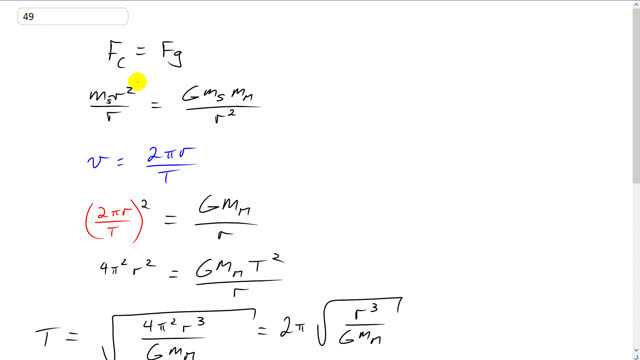
Calculate the period of a satellite orbiting the Moon, 95 km above the Moon’s surface. Ignore effects of the Earth. The radius of the Moon is 1740 km.

In order to watch this solution you need to have a subscription.
This is Giancoli Answers with Mr. Dychko. Centripetal force on this satellite orbiting the moon is being provided by gravity and that means the mass of the satellite times v squared over r—centripetal acceleration—equals the universal gravitational constant times mass of the satellite times mass of the moon divided by distance from the center of the moon to the satellite squared. And we also know that v in circular motion is the circumference of the circle, that's the distance divided by the period or the time to do one full circle. So this is circumference over the time it takes to do a circumference. And we can substitute that in for v. And also divide it both sides by mass of the satellite, in this line here, and multiply both sides by r, which makes it disappear on the left side and turns this into r to the power of 1. So, we have substituted for v here. And that becomes 4 π squared r squared and then the T squared; let's multiply both sides by that and we get it over on the right side. And then, we'll times by r over G mass of the moon; this becomes r cubed and 4 π squared over G times mass of the moon and we'll square root both sides though to solve for T—the period. And we can take this 4π squared out from the square root sign and make it into 2π and then plug in some numbers. So, we have 2π times the square root of 1740 times 10 to the 3 meters— radius of the moon— plus—the distance above the moon's surface—95 times 10 to the 3 meters and cube that result of that addition and divide by 6.67 times 10 to the minus 11 and then times by 7.35 times 10 to the 22 kilograms— mass of the moon— and you get about 118 minutes, after you take this result and times by 1 minute for every 60 seconds and that's the time to do one full orbit.
where did you get the mass of the moon?
Hi holly.perks,
Thank you for the question. I just looked up the mass of the moon in the collection of info in the "Other Useful Data" table on the inside cover of the textbook.
All the best,
Shaun
Why is the answer in minutes? I thought T was always seconds unless otherwise asked for.
Hi acw, thank you for the question. You're quite right that seconds are one of the standard metric units. Most of the time one should convert values into "meters, kilograms, seconds", which I abbreviate MKS units. However, with a final answer, I just had a personal preference for minutes since it's easier to imagine how long that is in comparison to our every-day human perception of time. Seconds would be quite correct, however. There's nothing more "correct" about minutes.
All the best,
Mr. Dychko